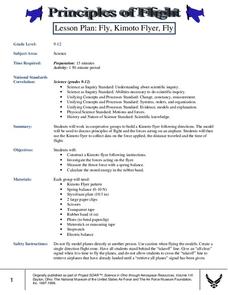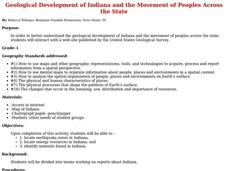Curated OER
Making A Compass
This interesting science instructional activity is about the compass. Students make a compass out of a magnet, sewing needle, cork, and a glass dish. The instructional activity includes both a pre and post-test for the students to take,...
Curated OER
Water and Ice
Students observe what happens to water as it goes from a solid to a liquid. In this exploratory lesson plan students gain an understanding for the water cycle while working in groups observing what happens to water as it changes state.
Curated OER
Preservation and the Power of Light
Students identify the effect of light on objects. In this scientific inquiry lesson plan, students use a chart to write a hypothesis about what will happen when colored construction paper is left in sunlight. Students observe and discuss...
Curated OER
Principles of Flight
High schoolers explore the principles of flight. In this flight activity, students construct a model plane and investigate the forces acting on the flier. They will measure the thrust and calculate the stored energy.
Curated OER
Locating Vent Fields Using CTD Data
Students describe the way hydrothermal vents work. Students work on locating vent regions through remote collection of data about water temperature and density. Comparing density and temperatures graphs, students search for indicators...
Curated OER
Magnets
Young scholars explore the science of magnets and how magnets work. They conduct a series of fun experiments and magnetize objects and demonstrate how magnetism operates right through other materials.
Curated OER
Ecology: Factors Influencing Animal Populations
Students assess the factors affecting animal populations. Working in groups they define specific vocabulary terms and complete several activities from "Project Wild."
Curated OER
Genetic Disorders with Cultural Roots: International Insects
Students recognize that certain populations have specific genetic disorders that could benefit or harm them in their environment, work out punnett square problems and infer offspring probabilities from results, and provide advantages and...
Curated OER
Design Project: Power Inverter
In this physics worksheet, students design and build a power inverter given a schematic diagram. They answer 3 short answer questions about the circuit they created.
Curated OER
Protecting Treasures
Students explore electricity by creating an alarm. In this circuitry instructional activity, students analyze a diagram of a circuit based alarm which detects sunlight. Students utilize electrical equipment to recreate the circuit and...
Curated OER
Pop Rockets
Students work together to design and build a paper rocket. They place a propellant in the contraption to make it fly. They discover Newton's third law of motion.
Curated OER
Rocket to Success
Students investigate action and reaction. For this energy lesson, students use a balloon and string to create a simple rocket. The will collect quantitative data record their observations, and relate their observations to Newton's Law...
Curated OER
Exploring Limu Diversity
Young scholars explore limu diversity. In this ocean ecosystem lesson, students classify limu according to its physical properties. Young scholars work in small groups to generate scientific observations and sort limu by characteristics.
Montana Office of Public Instruction
Eat Smart Be Smart
Get children's blood pumping with this primary grade lesson on the human heart. After learning about the important role this muscle plays in the human body, students monitor their heart rates and discover the importance of staying active.
Curated OER
Parts of a Solar Panel-Part I
Students examine electrical contacts, solar cells, and rechargeable batteries and compare and contrast the characteristics of a solar cell to a rechargeable battery in a hands-on activity. Students complete a worksheet as they...
Curated OER
Solar Kit Lesson #11 Power Maximum: An Electrical Determination
Young scholars identify and implement methods to standardize testing stations that measure solar panel output power. After collecting electrical ouptut data from several solar panels, they plot the current-voltage and power curves. ...
Curated OER
Watershed Investigations
Students find maps of the region to show rock formations and soil types and use GIS to compare radon levels. They describe three types of radioactive decay, interpret graphs, and follow steps to develop a nuclear bomb or energy.
Curated OER
Geological Development of Indiana and the Movement of Peoples Across the State
Fourth graders examine the geological development of the state of Indiana. Using the internet, they interact with the United States Geological Survey. They identify earthquake zones and energy resources in the state. They work...
Curated OER
Geological Development of Indiana and the Movement of Peoples Across the State
Learners are introduced to the geological development of the state of Indiana. Using the internet, they visit the U.S. Geological Survey and locate the earthquake zones in the state. In groups, they locate and identify the energy...
Curated OER
Environment
Students examine the energy saving benefits of trees. They identify ways in which trees reduce air pollution. They also work together to solve problems related to pollution.
Curated OER
How Does Your Garden Grow?
Students create a design for a school garden. In this garden design lesson plan, students analyze what plants grow best in their school's climate and work in teams to design a garden. Students measure the existing space, determine the...
Curated OER
The Big Meltdown
Pupils work together to develop a container to keep an ice cube in a solid state. They identify the three stages of matter and test different materials for this experiment. They share their results with the class.
Curated OER
Movement concepts
Students recognize the connection between food labels and exercise. In this health lesson, students understand how many times they need to dribble to work off a snack. Students answer questions about the exercise.
Sunlight Cal-Tech
Chromatography of Plant Pigments
Through a hands-on activity, an acetone-spinach solution is pre-made and learners use this solution to separate the pigments found in spinach using chromatography. The comprehensive resource includes an analysis and conclusion questions.

























